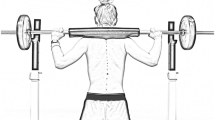Abstract
Purpose
This study aimed at investigating the effects of different body positions and axial loads on spinal stiffness to better understand spinal stabilisation mechanisms.
Methods
The posterior-to-anterior lumbar and thoracic spinal stiffness of 100 young healthy adults (mean age 23 years; 50 females) were measured in three test situations: prone, standing and standing while carrying a load equal to 50% of the subject’s body weight. Each test situation comprised three trials.
Results
Spinal stiffness in all test situations showed good reliability. Repeated measures analysis of covariance showed significantly higher spinal stiffness in standing than in the prone position [F(1/1694) = 433.630, p < 0.001]. However, spinal stiffness was significantly lower when standing while carrying a load of 50% of the body weight than when standing without additional load [F(1/1494) = 754.358, p < 0.001].
Conclusion
This study showed that spinal lumbar and thoracic stiffness increases when body position is changed from prone to standing. Additional axial load of 50% of the subject’s body weight results in reduced spinal stiffness during standing.
Graphic abstract
These slides can be retrieved under Electronic Supplementary Material.



Similar content being viewed by others
References
Shumway-Cook A, Woollacott MH (2001) Motor control: theory and practical applications. Lippincott Williams & Wilkins, Philadelphia
Panjabi MM (1992) The stabilizing system of the spine. Part II. Neutral zone and instability hypothesis. J Spinal Disord 5:390–396 (discussion 397)
Henderson CNR (2012) The basis for spinal manipulation: chiropractic perspective of indications and theory. J Electromyogr Kinesiol 22:632–642
Wong AYL, Kawchuk GN (2017) The clinical value of assessing lumbar posteroanterior segmental stiffness: a narrative review of manual and instrumented methods. J Phys Med Rehabil 9:816–830
Fritz JM, Whitman JM, Childs JD (2005) Lumbar spine segmental mobility assessment: an examination of validity for determining intervention strategies in patients with low back pain. Arch Phys Med Rehabil 86:1745–1752
Mergner T, Rosemeier T (1998) Interaction of vestibular, somatosensory and visual signals for postural control and motion perception under terrestrial and microgravity conditions—a conceptual model. Brain Res Brain Res Rev 28:118–135
Hodges PW, Cholewicki J, van Dieen JH (2013) Spinal control: the rehabilitation of back pain e-book: state of the art and science. Elsevier Health Sciences, Philadelphia
Chan ST, Fung PK, Ng NY, Ngan TL, Chong MY, Tang CN, He JF, Zheng YP (2012) Dynamic changes of elasticity, cross-sectional area, and fat infiltration of multifidus at different postures in men with chronic low back pain. Spine J 12:381–388. https://doi.org/10.1016/j.spinee.2011.12.004
Stokes IA, Gardner-Morse M (2003) Spinal stiffness increases with axial load: another stabilizing consequence of muscle action. J Electromyogr Kinesiol 13:397–402
Hofstetter L, Hausler M, Wirth B, Swanenburg J (2019) Instrumented measurement of spinal stiffness: a systematic literature review of reliability. J Manip Physiol Ther. https://doi.org/10.1016/j.jmpt.2018.03.002
Brodeur R, DelRe L (1999) Stiffness of the thoraco-lumbar spine for subjects with and without low back pain. J Neuromuscul Syst 7:127–133
Hodges PW, Eriksson AE, Shirley D, Gandevia SC (2005) Intra-abdominal pressure increases stiffness of the lumbar spine. J Biomech 38:1873–1880. https://doi.org/10.1016/j.jbiomech.2004.08.016
Shirley D, Hodges PW, Eriksson AE, Gandevia SC (2003) Spinal stiffness changes throughout the respiratory cycle. J Appl Physiol 95:1467–1475. https://doi.org/10.1152/japplphysiol.00939.2002
Stanton TR, Kawchuk GN (2009) Reliability of assisted indentation in measuring lumbar spinal stiffness. Man Ther 14:197–205. https://doi.org/10.1016/j.math.2008.01.011
Leach RA, Parker PL, Veal PS (2003) PulStar differential compliance spinal instrument: a randomized interexaminer and intraexaminer reliability study. J Manip Physiol Ther 26:493–501. https://doi.org/10.1016/S0161-4754(03)00106-4
Girod B, Rabenstein R, Stenger A (2003) Einführung in die Systemtheorie. Vieweg+Teubner Verlag, Wiesbaden
Stanton T, Kawchuk G (2008) The effect of abdominal stabilization contractions on posteroanterior spinal stiffness. Spine 33:694–701
Lee M, Steven GP, Crosbie J, Higgs R (1998) Variations in posteroanterior stiffness in the thoracolumbar spine: preliminary observations and proposed mechanisms. Phys Ther 78:1277–1287
Owens EF, DeVocht JW, Gudavalli MR, Wilder DG, Meeker WC (2007) Comparison of posteroanterior spinal stiffness measures to clinical and demographic findings at baseline in patients enrolled in a clinical study of spinal manipulation for low back pain. J Manip Physiol Ther 30:493–500
Holdsworth F (1970) Fractures, dislocations, and fracture-dislocations of the spine. J Bone Jt Surg Am 52:1534–1551
Campbell BD, Snodgrass SJ (2010) The effects of thoracic manipulation on posteroanterior spinal stiffness. J Orthop Sports Phys Ther 40:685–693
Swanenburg J, Meier ML, Langenfeld A, Schweinhardt P, Humphreys K (2018) Spinal stiffness in prone and upright postures during 0–1.8 g induced by parabolic flight. Aerosp Med Hum Perform 89:563–567
Gardner-Morse MG, Stokes IA (2003) Physiological axial compressive preloads increase motion segment stiffness, linearity and hysteresis in all six degrees of freedom for small displacements about the neutral posture. J Orthop Res 21:547–552
Rose JD, Mendel E, Marras WS (2013) Carrying and spine loading. Ergonomics 56:1722–1732
Bobet J, Norman RW (1984) Effects of load placement on back muscle activity in load carriage. Eur J Appl Physiol 53:71–75
Funding
No Funding.
Author information
Authors and Affiliations
Corresponding author
Ethics declarations
Conflict of interest
The authors declare that they have no conflict of interest.
Ethical approval
The ethics committee of the Canton of Zurich approved this study (BASEC-Nr: 2017–01245). It was registered at ClinicalTrials.gov (Identifier: NCT03495843).
Informed consent
Informed consent was obtained from all individual participants included in the study.
Additional information
Publisher's Note
Springer Nature remains neutral with regard to jurisdictional claims in published maps and institutional affiliations.
Electronic supplementary material
Below is the link to the electronic supplementary material.
Rights and permissions
About this article
Cite this article
Häusler, M., Hofstetter, L., Schweinhardt, P. et al. Influence of body position and axial load on spinal stiffness in healthy young adults. Eur Spine J 29, 455–461 (2020). https://doi.org/10.1007/s00586-019-06254-0
Received:
Revised:
Accepted:
Published:
Issue Date:
DOI: https://doi.org/10.1007/s00586-019-06254-0




